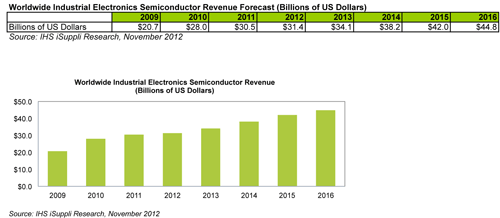Growth Outlook for Industrial Electronics Semiconductors Dims in 2012
El Segundo, Calif. (Nov. 15, 2012)—The growth of the industrial electronics semiconductor market is set to fall short of previous expectations in 2012, as the business is buffeted by weakening global economic conditions, according to an IHS iSuppli Industrial Electronics Market Tracker Report from information and analytics provider IHS (NYSE: IHS).
Revenue for industrial semiconductors—used in a wide array of application markets from home automation to aeronautics and military purposes—is projected to finish the year at $31.4 billion, up 3 percent from $30.5 billion in 2011. This year’s meager expansion contrasts with the solid 9 percent increase of last year and the exuberant surge of 35 percent in 2010 immediately after the recession. It also represents a significant downgrade from the previous forecast of 7.7 percent growth issued in July.
This year will bring the slowest growth for the next four years, with revenue set to rise in a range from 7 to 12 percent during each of the next four years. Revenue is forecast to reach $44.8 billion by 2016, as shown in the figure below.

“The chip revenue forecast was dialed back after economic headwinds got stronger in the second quarter, affecting several top semiconductor suppliers and original equipment manufacturers of industrial electronics,” said Jacobo Carrasco-Heres, industrial electronics analyst at IHS. “And when hoped-for growth did not pan out as expected and sales eventually came out lower, the market was downgraded to reflect the changed circumstances.”
Industrial giants feel the impact
Among the companies affected by the downturn in industrial semiconductors are Texas Instruments, Analog Devices Inc., Infineon Technologies, Atmel, Fuji Electric and Linear Technology. Manufacturers that have lowered their 2012 outlook because of weaker orders include Danaher, Siemens, Bombardier, Agilent, Vestas and Johnson Controls.
Industrial semiconductors are used in many markets and applications. In energy generation and distribution, for instance, the chips are employed in wind turbines for renewable power, in inverters for photovoltaic solar energy, as well as in conventional oil and gas automation machinery. The semiconductors play an important role in military and civil aerospace, via applications in missiles and munitions, homeland security, satellites and avionics.
Other areas where industrial semiconductors are used include building and home control, covering security systems, lighting, smart meters and climate-control devices like air conditioners; medical electronics, including medical instruments, medical imaging and diagnostics; manufacturing and process automation, embracing motors and similar devices; and the test and measurement segment for a range of instruments, such as oscilloscopes and analog testers.
LEDs lead the way
“The one segment that seemed to have remained untouched this year was the robust light-emitting diode (LED) market, thanks to the LED lighting boom that has taken hold in many parts of the world,” said Robbie Galoso, principal analyst for electronics at IHS.
Second-quarter LED sales for Philips climbed 37 percent from year-ago levels, and other LED lamp suppliers like Cree, LG Innotek and Samsung LED also enjoyed solid second-quarter results.
There were other manufacturers that performed well during the period, scattered throughout various segments. Among them were Honeywell with 8 percent growth, driven by commercial avionics; General Electric with an industrial sales increase in the double digits, on the strength of a 27 percent rise in transportation; and Alstom, ABB, Delta and Mindray in other industrial sales segments.
Still, global economic concerns continue to trouble the industrial electronics industry as a whole. The financial worries of the euro zone, along with slower expansion in China and the ongoing high unemployment rate in the United States, threaten to derail any growth anticipated in the future, especially if markets take a turn for the worse.
As a result, manufacturers in the space have issued a cautionary warning for the short term amid the generally lowered outlook for the year, even though industry players remain hopeful that improved conditions could be on their way.
Advertisement
Learn more about IHS iSuppli





